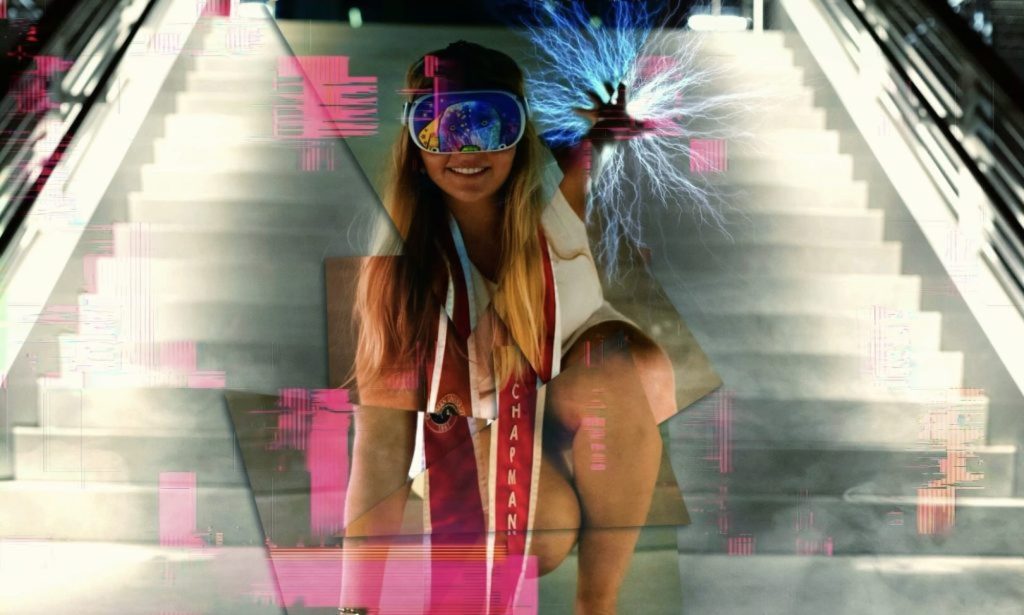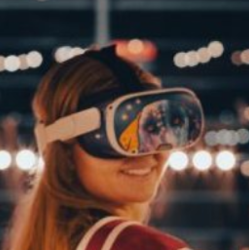Group Collaboration Project
MA Virtual Reality, MA Visual Effects & BA Sound Design

We came back after Christmas break with something that was very exciting awaiting us. The collaboration project was one that I was especially excited before since we would be working with other Master’s courses. I was excited to work on a team with creatives with various specialties.
Meet up day
I met lots of students in MA games design, MA VFX, and MA animation. One of the last people that I talked to was Brad and we bonded over VR and creating a genuine travel experience. He was from Canada and had a cool vibe; we also bonded over music. He had a peer named Louis and he joined our group. We all got coffee and talked about making a mind bending experience with kaleidoscopes, VFX, and lots of particle systems.
Virtual Affects Team

Our tutor suggested we join groups with Rita since they had a similar focus and wanted to do an escapism/meditation experience. I spoke to Rita’s colleagues during our meet up mixer and I thought they were interesting and could be potentially valuable group members. I was intrigued and completely supportive of joining forces to create a bigger group.
The expanded group benefited us in multiple ways such as creating more scenes, art, motion capture, animations, and VFX. Together we used the strengths of two MA VR Students and 4 MA VFX Students. While trying to discover our group and project name, I did some math… Virtual Reality x Visual Effects = Virtual effects… Later the name was changed to Virtual Affects as we pursued an experience that would AFFECT the user’s mood in some way.

Collaboration tools
I used Miro to plan out all of the activities and objectives in a weekly timeline. I also assigned everyone on the team goals and organized them in the timeline. We split up the work based upon scenes: I took Winter Wonderland, Brad and Louis (MA VFX students) took our trippy and energetic scene, Rita designed the main menu, and Atia and Carlotta (MA VFX students) took our calming Zen garden scene.
Concept
We started mind-mapping concepts for our project, this helped us establish the overall aesthetic and theme we wanted to create. Using inspirational and conceptual images on our mood board, we are creating a fully immersive VR environment, using surreal and imaginative elements to create a sense of escapism for the user. We aim for the experience to be mindful, relaxing and be a sense of relief for the user specifically designed for those with mental health conditions such as anxiety and depression. Our experience has three different scenes involving three portals that will take you to different environments. We want each environment to leave the user feeling either BLISSFUL, OUT OF THE WORLD, or CALM. The choice of the environment the user selects will depend on how they’re feeling in that moment. We have a Winter Wonderland scene which is playful, A TrippyScope scene that will leave the user feeling energized, and finally a Zen therapy scene that will leave the user feeling calm.
My To Do List
I was happy to take Winter Wonderland because we decided that this scene would be the most interactive and playful. I was excited to design a character and come up with exercises that I would later program throughout my story. I started right away on my vision of this. Here is the list of objectives I wanted to achieve.

I had learned from my mistakes last term that planning everything out in the beginning is a great way to stay on track and work towards goals. I also realized that even though this was my plan, It changed many of times along the way, and that is okay! My ideas were improving after every test and conversation I had with this project. 
We chose this asset pack because it was a very cute theme and we wanted to use a penguin as a sensei. We matched the scene with a cute and playful penguin
https://assetstore.unity.com/packages/3d/vegetation/story-northern-nature-164556
Character Design
Peter the Penguin comes from a time that I went ice skating with one of my first VR friends in London. It was my birthday and she had only ice skated a few times before. We borrowed a penguin that little kids used as tools to help them skate. My favorite animal just so happend to be a penguin so I was excited to make this character come to life.

Clara is a friend that I met through the volunteering for Aesthetica Short Film Festival in York.
She studies in the BA Virtual Reality course.
Peter’s Role: Meditation Sensei
An introduction comes from Peter at the beginning and he tells you a little bit about each portal. Peter’s home is the winter wonderland. If the user chooses to go into the Winter Wonderland, Peter will guide them!
Peter’s personality is cute and cuddly. He is goofy and hard not to like! As the story progresses, the story goes from playful and blissful, to exercises where you practice letting go and releasing negative energy. Peter is there through it all!
Storyboard


Interaction Design

Animations
Animations: I practiced animations on a cylinder and you can do that here. I figured the best way to do this on top of mixamo animations would be to animate a parent object and attach my penguin to it. You can see that I have done that here.
Peter had two different ways of being animatired.
In Mixamo I did the basic animations such as walking. I put him a continuous looping walk and then I used an empty game object create a parent and then i created the animation route.
The other animations that I needed for Peter would be the talking animation. I asked one of my group memebers to animate this in Maya and we used the same animation for each bit of him talking. The fun part was when we needed to animate Peter screaming. This part was more customized so we really had to match the animation with a time linee
Timeline
Timeline was an extremely useful tool to our project. We used the time to sync up voice and animations. This was perfect because I could see exact when each sound would be played.


I used another method of keeping time to switch scenes. This is the script that I used with animation controller so that I could have the user open their eyes when the breathing meditation was over. I set this active by using a trigger to SetActive this scene manager.

Burning Paper Excercise
This exercise was to focus specifically on letting go of negative thoughts. Peter tells you to write on a black which I created this function using a second camera and here is the tutorial I followed.
Once I got the paper drawing the way that I wanted it to, i used a rectangle behind the “paper” and disabled the mesh renderer. I attached a grab intractable script to this and then used this script to destroy the game object and activate a fire explosion and sound.
The user then begins intense hike on their own which signifies that they are strong on their own. The hike and the music get add dramatic affects as the music gets louder and snow begins to fall.
At the top for the hike i use a collider and a animation timer set to have the user close their eyes and open them when the timer runs out and they are qued to open their eyes with the chime that plays as the Northern Light scene comes up.
Footsteps to guide the user
One of the first big issues I realized was that my environment was so big that it would be so easy for people to get lost. Originally, that was one of Peter’s main purposes. He would be walking in front of the user the entire time and I was hoping that the user would follow the,. Within testing, I knew it was inevitable that people would get lost unless I added another method to guide them.
I started by adding a path that they could look for to show them exactly the path to get to the next scene.
I used footprints of a penguin to guide the user where i wanted them.
This is what the footprints look like…





Fire activation
I used this script for interactions in the Zen Garden and in the TrippyScope.

This script used the match to light candle sticks. 
Here I used a torch to set fire to some firewood.
In Trippyscope, I used the script to light a campfire and in ZenRapy, I used a match to ignite fire to candles. The difference between the scripts is only in the game objects, tags, and what it is setting active. They both run the same way.
In Winter Wonderland I also used this script but this time, the fire was meant to burn and destroy the paper, so instead I used an explosion to signal when the fire paper had been burned and I used a fire particle system with a box collider on it to trigger the paper in the fire being burned. I used a similar script here but just changed up the tag.

Portals
Portals were part of the user journey to get from one scene to the next. All the user had to do was walk into the portal and they would be taken to the next scene, like this…
I created that by placing a box on the portal and using this script to change scenes when the user walks into it.

TrippyScope
TrippyScope was a scene that I would be working on with Brad and Louis. We all talked about something creating something trippy and create an illusion. Our inspiration first came from this video.
Brad suggested that we make shapes and animate those around the user. These are the beginning of the kaleidoscope which i late brought into unity and changed the colors up.
I got two portal packages from the unity asset store that I really liked and put in there to make it feel like you are out of this world.
Brad took longer than expected to model the world and get the textures to me so I began creating the interactions in a scene that was untextured.

We turned the scene from looking like this, to this…
How?
I created a shader and added it along with other trippy materials to my scene.


This castle gives the user a new perspective as they teleport to it and see the best view! 
Peter showed up to the party! 
Transparent Cherry Blossom Tree
Scene Change Script on timer animation
Sound
Sound went very smoothly. Cai especially was very helpful and a great asset to the group. I gave him a walkthrough of what I had completed of Winter Wonderland. While showing him the game, I told him what kind of sounds that I imaged with interaction, as well as 360 sounds I wanted to add with the scenes. He took notes and within a week he gave me back a whole playlist that I was then able to put into my scene. This brought my game to the next level of immersion.
Cai was extremely useful to the group when it came to voice recording. He helped book a sound recording studio and provided a nice microphone for us to use for voice recording. Rita played as Peter using the script that I wrote and we broke up the recordings scene by scene. He even volunteered to do our voice acting for the Zen Garden scene.




Peter Screaming 
I also showed Raul the ideas we had prepared for TrippyScope. He was a bit nervous because he said he usually doesn’t make songs but I think he did well with the end product!



Testing


